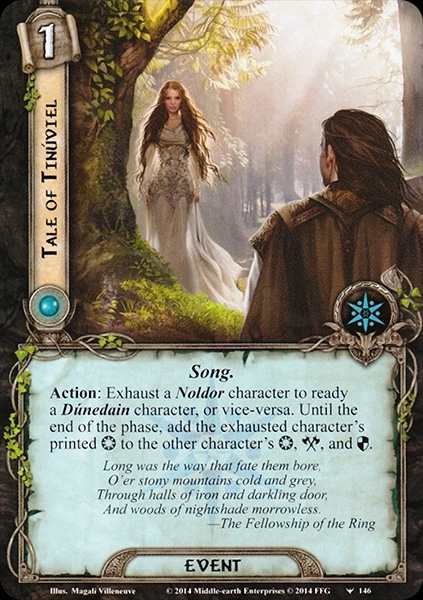It's been a while (about 2 years) since I wrote a card review, but playing a deck I built around this card makes it clear that it requires one! This is a deceptively powerful and versatile card that actually takes a little bit of skill and timing to play to optimum effect....which are ALWAYS my favorite cards in the game. Also worth mentioning...the stunning Magali art combined with an amazing lore reference, and how it's connected to the mechanics thematically make this card an absolute masterwork of game design that ANY game designer should be proud of.
Thematically, it represents the historic alliance and bond of trust between the Edain (the men who would turn away from the Shadow and turn towards the light of the Eldar) and the Noldor in their struggles against Morgoth in the land of Beleriand during the First age of Middle Earth. The epitome of this bond was realized in the love story between Beren, one of the greatest heroes of the Edain; and Luthien Tinuviel, the most beautiful evening star of the High Elves. This ancient lay is repeated in the third age with the bond between Arwen Undomiel and Aragorn crowned King Elessar of Gondor. It's the sort of powerful stuff that sets Tolkien in a different league from other fantasy authors.
Mechanically, it is basically what I'd call an action exchanger, sort of like Spare Hood and Cloak....trading the action of a Noldor character for the action of a Dunedain character with an added perk of a +1 to +3 global stat boost for a phase (based on the of the exhausted character). There are two basic ways that it is used in gameplay..... either to trade willpower for combat power between two "powerful" characters, or to trade off the action of a "weenie" to give to a powerful character (likely with a +1 stat bonus). Essentially it basically smooths out the needs of willpower vs. combat in a particular round with action advantage and a stat boost.
An example of the "weenie" use is pretty straightforward. You play a card like Elven Jeweler and leave them standing for the express purpose of readying a more powerful character like Aragorn in the phase that he is most needed.
Between more powerful characters, it is a little more nuanced (and powerful if used correctly). The ideal is to exchange the action of a high character, such as Arwen Undómiel, to ready a character with all around decent stats, like Aragorn. What is even more nuanced is that you can optimize the timing on this effect to fine tune it to the demands of the round. I will demonstrate with the following examples.
If questing is the priority, you exhaust Arwen Undómiel AFTER committing Aragorn to the quest to ready him. The result is that you add her willpower to his and get the net effect of having Aragorn readied for later phases. If the priority is combat power, than you simply commit Aragorn to the quest and leave Arwen Undómiel readied until the combat phase. Once the combat phase starts, you exhaust Arwen Undómiel to ready Aragorn. This has the net effect of sacrificing 1 (since you essentially quested with Aragorn's 2 vs. Arwen Undómiel's 3 in trade-off), and then readying Aragorn during the combat phase with a very powerful +3 global boost to his combat stats.
I'm sure there are several other creative uses for this card (like readying action based abilities such as Beravor) and other timing nuances that I haven't even mentioned. In short, any deck that has spirit and a combination of Noldor and Dunedain characters should probalby have atleast 1x copies of this card, if not more.
In short, it is a nuanced, potentially powerful, stunningly beautiful, delightfully thematic card that represents the soaring heights of game design and theme that have been accomplished in this game.
